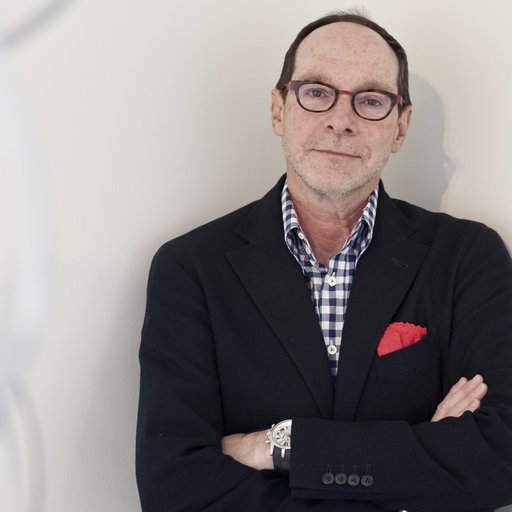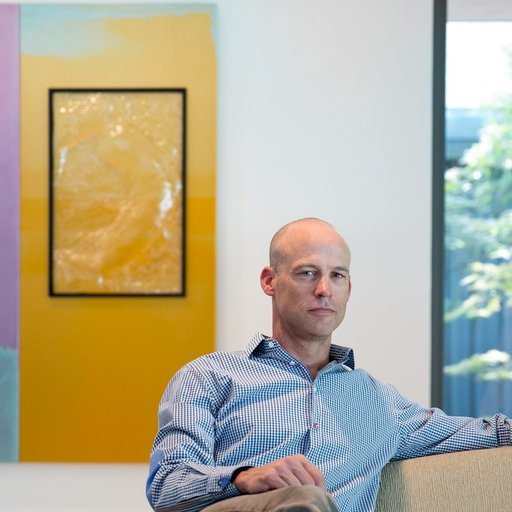Over the last 15 years, Michael Shvo has made a name for himself, and a good deal of money, in the Manhattan real estate game. And for about a decade he has been putting some of those earnings into art. The two sides of his life came together last September, when he turned a gas station awaiting redevelopment at the corner of 24th Street and 10th Avenue in Chelsea into an urban oasis, planting rolling hills between the pumps with grass and setting loose a flock of sculptural sheep by Francois-Xavier Lalanne. That was followed in November by a show of design and sculptural works by Lalanne and his wife Claude at Sotheby's S2Gallery that Shvo co-curated with the art dealer Paul Kasmin.
To learn more about Shvo's passion for art and design, Artspace visited him at his New York City home. The apartment high in the Time Warner towers manages to upstage sweeping views of Central Park with its sumptuous decor—a fur rug, Venetian plaster walls, paneling of exotic wood veneers—and a stellar art collection. In the foyer are an Andy Warhol flower painting as well as one of his "Diamond Dust" shoe paintings; just around the corner at the entrance to the living room, a couple Warhol boxes are stacked near a pair of marble owl sculptures by Claude Lalanne. Shvo talked about what first drew him to art and what keeps him coming back.
What is your approach to collecting?
Art collecting is something that many different people see in many different ways. For me it's very simple. I have no education in art. I have never used an art consultant. For me it has to be beautiful, you have to connect to it, it has to make you happy. I am not the guy who collects works that are very conceptual and that need to be explained by somebody to enjoy them. When we collect art, we sometimes buy a one-off by an artist, a piece we really love, but more likely we collect very deeply either an artist or within a period.
Clearly Pop art—Warhol in particular—is one of the areas you have focused on.
Obviously this room is mostly Warhol. Somebody Wants to Buy Your Apartment Building, from the "Ad" series, nicely connects to what I do when I don't collect art. There are the Warhol shoes, which I find truly elegant, particularly these ones because of the black-on-black scheme. It's a work that we had been wanting for a while—we already had the color version in the entry, and then this came up at auction at Christie's. You see the boxes—the Brillo, the Heinz, the Campbell's Soup, and the Cornflakes—throughout the house.
One of my favorite pieces in the house is Tom Wesselman's Mouth Number 8. It's from 1966, and we are only the second owners. The piece was commissioned by Hugh Heffner directly from Wesselman, and it was in the Playboy collection until we bought it a few years back. When you own art there are always works that you see by an artist and think, 'I'd love to have that.' I think I'm quite lucky because, to me, this is one of those pieces—it's Wesselman's best work. There is no other work of his that I would say, "I'd sell this if I could get that—at any price." It's so iconic. The symmetry and the architecture of this work. Even though it's a shaped canvas, this to me is the quintessential Pop painting.
Was Pop what drew you to collecting? When did you first become interested in art?
My family didn't have art—my parents are chemists—but my mother was obsessed with taking us as children to museums and duomos. So I think from an early age I knew what I liked and didn't like. And I think this later played into my developing properties with a very strong design element. I was fortunate in my early thirties to be quite successful and the first piece I bought was a Murakami print for like $8,000 at one of those Sunday sales that Phillips had in the early 2000s. I had been going to galleries for enjoyment, but then I started following auctions. The next thing I bought was a Gene Davis painting and then a Bertoia sculpture.
A Gene Davis painting seems a little surprising as as an entry-level item—it's not seductive like a Murakami is.
It's colored line on a canvas! But in my aesthetic everything has a relation to architecture. And a Gene Davis painting reflects my taste in architecture, which is very structural, very symmetrical. His work led me to the entire group of color field painters who I have been collecting for over a decade: Josef Albers, Paul Feeley, Richard Anuszkiewicz, Frank Stella. They have this great idea of the architecture of the painting. Even with someone like Morris Louis—and we have a fantastic Morris Louis in the Hamptons—there is that architecture and that symmetry even though the work is a lot more abstract. Our house in the Hamptons is very structural—it looks like a 1960s mid-century Modern house, it's a white box with glass, so the color field just works so well there. And the beautiful thing is we have embedded that environment with Lalanne work. But to me Lalanne just works everywhere. It's almost an obsession at this point.
There is also quite a bit of work by the Lalannes here in Manhattan, too. Do you consider yourself a design collector as well, or do the Lalannes in particular attract you?
We do collect design, there is quite an extensive collection of André Sornay, one of the greatest Art Deco furniture makers of the 1930s. But I also don't really consider the Lalannes to be design. This crocodile chair could be thought of as a chair, but to my mind it's a sculpture. Also it's probably not the most comfortable chair, but it is the most beautiful chair. The same with the monkey table here, and the crocodile bench over there. As far as the sheep, which are kind of the quintessential François, I think this is very much the way he imagined for them to be displayed, he wanted to bring the French countryside into the Parisian home. By the way, we actually have the second one that he ever made. When you try to put your fingers into the guts of the sheep it's all stuffed with newspapers and hay, and it's very primitive the way it was done.
These are the indoor sheep, but were those also your sheep in the Chelsea gas station?
Most of them were—15 were from my collection and 10 were from Paul Kasmin's collection. But those were all outdoor sheep, made of concrete, epoxy, and bronze. We have those in the Hamptons roaming around the garden together with another half-dozen Lalannes—the big monkey, the rabbit, the big deer.
When did you begin to collect the Lalannes?
I discovered them by sheer mistake. I was developing at 20 million-square-foot island in Abu Dhabi in 2007 and I hired Herzog & de Meuron to do the master plan, and then I hired 30 architects to design different parts of the island. For the Marina, I hired Peter Marino. When he came over on an early trip, it was the first year of the Art Dubai fair. We walked in and came to the Ben Brown gallery, and there was this big apple with a monkey—that piece was a collaboration between François and Claude—and as Peter was telling me about these artists, Paul Kasmin came walking up and introduced himself. I didn't buy anything because I couldn't decide—I wanted everything. Shortly afterward, I started buying Lalanne works from Paul and continue doing so to this day.
Was the gas station a collaboration with Paul?
Well, I had bought the property and I know everybody thinks that the gas station is just such an ugly thing there on the corner. One morning I just woke up with an idea. I drew the sheep meadow, and I picked up the phone and called Paul and said, "What do you think?" And he said, "Sounds great." To me that was just a way to beautify something that people thought was unattractive, and also to introduce the Lalannes to people who might now know the work.
The beauty of it was that it spoke at different levels to different people. The six-year-old who goes to Avenues School would walk by and stare. I had them ask me, "Is that real grass?" Of course it was real grass—if you do something you have to do it right. Then there were people who took a more philosophical approach and thought you are taking something polluting the environment and turning it into something green. And then you had collectors who already understood that is what the Lalannes stand for—they are Surrealists. When Claude came from Paris she thought it was fabulous, and she said her husband would have loved it.
Do you continue to collect in all these areas or did you find that you moved from Color Field to Pop to the Lalannes?
When you have something beautiful and you look at buying something else, it has to be as good. So we haven't necessarily seen Color Field work in the last couple years that we had to live with. But we still follow everything that comes up. We are still looking. We go to auctions, we go to opening, we travel a lot to see art and to go to fairs.
Do you have a preference for buying at auction or at fairs or galleries?
The thing about auction is that if you have insecurities about what you are buying, when you have someone next to you raising their hand saying they want to spend a million dollars, that gives you confidence. I don't really have a preference, but at art fairs in general—I mean the big ones, Basel and Frieze—we buy less because there is this kind of grand hysteria. If you look at the fairs, they are mostly populated by a lot of very contemporary work, very conceptual work, less Pop, less Color Field. But its really about finding the right work—we bought a Warhol flower painting at Miami a few years back.
And we do have plenty of things that do not fit the categories. We own a great Adam McEwen that we bought in 2005 when nobody knew who he was, we own a Harland Miller, one of his covers of Penguin books. In the bedroom we have some works that are kind of pornography-esque—some Thomas Ruffs, we have Timothy Greenfield-Sanders portraits of Jenna Jameson. And we're always looking. Hayv Kahrahman is a new Iranian artist we discovered and love, and who we bought two pieces by. I bought the works a while ago from the Third Line gallery, but she is now represented by Jack Shainman in New York. It doesn't necessarily fit in a category we collect, but we saw it and my wife and I liked it, so we wanted it. The idea is always simply to go after what is beautiful—that idea translates in to architecture, in to design, and clearly into art.























